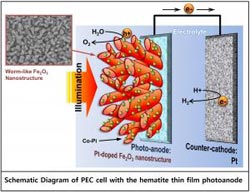Wormlike hematite photoanode breaks the world-record for solar hydrogen production efficiency

Schematic Diagram of PEC cell with wormlike hematite photoanode <br>Copyright : UNIST <br>
This research was published in Scientific Reports, a science journal published by the Nature Publishing Group. (Title: “Single-crystalline, wormlike hematite photoanodes for efficient solar water splitting”) on 17 September 2013).
The previous record of solar hydrogen efficiency among stable oxide semiconductor photoanodes was 4.2% owned by the research group of Prof. Michael Graetzel at the Ecole Polytechnique de Lausanne (EPFL), Switzerland.
Solar water splitting is a renewable and sustainable energy production method because it can utilize sunlight, the most abundant energy source on earth, and water, the most abundant natural resource on earth. At the moment, low solar-to-hydrogen conversion efficiency is the most serious hurdle to overcome in the commercialization of this technology.
The key to the solar water splitting technology is the semiconductor photocatalysts that absorb sunlight and split water to hydrogen and oxygen using the absorbed solar energy. Hematite, an iron oxide (the rust of iron, Fe2O3) absorbs an ample amount of sunlight. It has also excellent stability in water, a low price, and environmentally benign characteristics.
Thus it has been a most popular and promising candidate of photoanode material for solar water splitting over the last two decades. However, hematite has a major and critical drawback of an extremely poor electrical conducting property. Thus most of the hematite anodes have exhibited very low performance.
Prof. Jae Sung Lee of UNIST led the joint research with Prof. Kazunari Domen’s group at the University of Tokyo, Japan, developing new anode material which has outstanding hydrogen production efficiency.
Prof. Lee and coworkers employed a series of modifications to improve the property of hematite. First, a unique single-crystalline “wormlike” morphology was produced by using a nanomaterial synthesis technique. Second, a small amount of platinum was introduced into the hematite lattice as doping. Finally, a cobalt catalyst was employed to help oxygen evolution reaction. These modifications reduced energy loss due to charge recombination and brought the record-breaking solar-to-hydrogen conversion efficiency.
“The efficiency of 10% is needed for practical application of solar water splitting technology. There is still long way to reach that level. Yet, our work has made an important milestone by exceeding 5% level, which has been a psychological barrier in this field,” said Prof. Lee. “It has also demonstrated that the carefully designed fabrication and modification strategies are effective to obtain highly efficient photocatalysts and hopefully could lead to our final goal of 10% solar-to-hydrogen efficiency in a near future.”
The fellow researchers include Jae Young Kim from UNIST who performed most of the experiments oscillating between two laboratories in Ulsan and Tokyo, and researchers from POSTECH and the University of Tokyo.
This research was sponsored by the A3 Foresight Program of the Korean National Research Foundation which supports international collaboration projects between three Asian countries of Korea, China and Japan.
Homepage of Jae Sung Lee http://ecocat.unist.ac.kr
Ulsan National Institute of Science and Technology (UNIST) http://www.unist.ac.kr
The original press release
https://www.unist.ac.kr/board/view.sko?boardId=Notice&boardSid=5037&menuCd=AB07002001000&contentsSid=8297&orderBy=register_dt&startPage=1&searchType=&keyword=&searchStartDt=&searchEndDt=&dataSid=2354163
Associated links
http://www.unist.ac.kr
http://ecocat.unist.ac.kr
Journal information
Scientific Reports
Funding information
A3 Foresight Program of the Korean National Research Foundation
Media Contact
All latest news from the category: Power and Electrical Engineering
This topic covers issues related to energy generation, conversion, transportation and consumption and how the industry is addressing the challenge of energy efficiency in general.
innovations-report provides in-depth and informative reports and articles on subjects ranging from wind energy, fuel cell technology, solar energy, geothermal energy, petroleum, gas, nuclear engineering, alternative energy and energy efficiency to fusion, hydrogen and superconductor technologies.
Newest articles

Silicon Carbide Innovation Alliance to drive industrial-scale semiconductor work
Known for its ability to withstand extreme environments and high voltages, silicon carbide (SiC) is a semiconducting material made up of silicon and carbon atoms arranged into crystals that is…

New SPECT/CT technique shows impressive biomarker identification
…offers increased access for prostate cancer patients. A novel SPECT/CT acquisition method can accurately detect radiopharmaceutical biodistribution in a convenient manner for prostate cancer patients, opening the door for more…

How 3D printers can give robots a soft touch
Soft skin coverings and touch sensors have emerged as a promising feature for robots that are both safer and more intuitive for human interaction, but they are expensive and difficult…





















